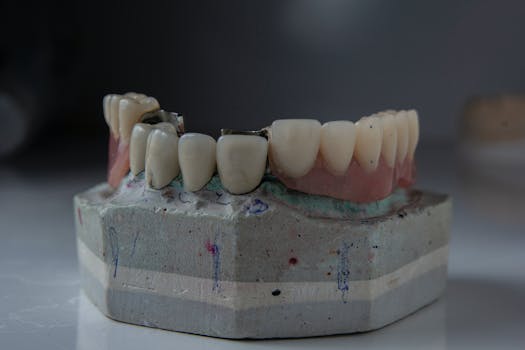Choosing the right dental filling
In the world of dentistry, there are many ways to improve and maintain your dental health. One of the most common treatments at any dental practice is the placement of fillings. Whether it's treating tooth decay or restoring a damaged tooth, the right choice of filling materials can be crucial to ensuring both the long-term health and aesthetics of your teeth. In this post, I want to give you an in-depth look at the different types of dental fillings and help you understand the best option for your needs.



What are dental fillings?
Dental fillings are forms of treatment used to replace lost tooth structure caused by decay or tooth damage. The process usually begins with the dentist cleaning the affected tooth of decay and then inserting the filling material to restore the structure and function of the tooth.
Types of dental fillings
There are different types of filling materials, which are selected depending on the location of the tooth defect, the aesthetic requirements and the chewing pressure load:
Amalgam fillings
These are traditional fillings that are often used in posterior teeth due to their durability and strength. Despite their effectiveness, they tend to be visible and are therefore not recommended for anterior teeth.
Composite filling
Also known as resin fillings, these fillings offer a tooth colour that is well suited to the front teeth. They harden under light curing and offer good durability with medium chewing pressure. These plastic fillings are tooth-coloured and ideal for anterior teeth or visible posterior teeth.
Ceramic fillings
These are often made of porcelain and are known for their aesthetic qualities. Ceramic inlays and onlays are particularly popular as they offer excellent colour stability against discolouration.
Gold fillings
Are known for their exceptional durability and are primarily used in molars, where aesthetic aspects are less important. Due to their robustness, they are particularly suitable for the posterior region, where chewing pressure is strongest. This durability makes gold an excellent choice for areas subject to high stress.
Glass ionomer cement
Ideal for deciduous teeth or as a temporary filling as they release fluorides that help prevent decay.
Inlay fillings: Precise restoration for long-lasting dental health
In modern dentistry, inlay fillings are a specialised form of dental treatment that offers both functional and aesthetic benefits. This type of filling material, which includes inlays, is often used to repair a damaged tooth whose chewing surface has been significantly affected by decay. Unlike traditional fillings, which are placed directly into the tooth, inlays and onlays are precisely crafted in a dental laboratory to ensure that they fit exactly into the cavity.
A major advantage of this technique is that it preserves more of the natural tooth structure, which is particularly good and important when the alternative would be to use a full dental crown. This can also help to minimise toothache, which often occurs when a tooth is severely damaged and conventional filling materials are not sufficient to effectively protect and strengthen the tooth. In the meantime, while the final inlay or onlay is being made, a temporary filling can be placed to prevent further damage and keep the tooth functional.
This technique not only provides a robust solution to extensive tooth loss, but also serves as a long-term tooth replacement that can improve overall oral health. By using precisely crafted inlays, patients can expect an effective and long-lasting treatment that minimises the need for further procedures and contributes to better overall oral health.
The choice of material will depend on your specific needs, aesthetic preferences and the condition of the affected tooth. A high-quality dental laboratory is often consulted to create specialised fillings such as inlays or onlays that are perfectly adapted to the shape and size of the cavity.
Choosing the right filling material
Choosing the right filling material depends on several factors:
Aesthetic desires: For visible areas such as the front teeth, tooth-coloured materials such as composite or ceramic are ideal.
Chewing pressure: In areas with high chewing pressure, such as the molars, stronger materials such as gold or amalgam are more favourable.
Cost: Costs can vary, with materials such as gold and ceramic generally being more expensive than composite or amalgam.
Long-term durability: Some materials, such as ceramic and gold, offer longer durability compared to composite fillings.
Filling therapy: steps to a healthy smile
Filling therapy always begins with a thorough examination by your dentist. This is crucial to accurately determine the extent of the decay or tooth damage. The dentist will examine the tooth nerve and the surrounding tooth surface to ensure that the correct treatment procedure is used.
Examination and preparation
Once the affected tooth has been identified, the area around the neck of the tooth is carefully cleaned to remove all caries bacteria. This prevents further spread of infection and prepares the cavity for the filling.
Curing and polishing
Once the filling material has been placed, it must be allowed to harden. This process can vary depending on the material used. Composites and compomers cure under a special light source, while ceramics and glass ionomers cure chemically.
Once the material has cured, the filling is carefully polished to ensure that the surface is smooth and replicates the natural enamel. This is important to ensure seamless integration into your dental arch and to prevent plaque build-up at the edges of the filling.
Aftercare and maintenance: your contribution to the longevity of your filling
After the filling has been placed, it is crucial to follow excellent oral hygiene practices. This includes regular visits to the dentist to monitor the condition of the filling. It is equally important to avoid hard foods and watch for signs of teeth grinding, which can put additional stress on fillings.
Oral hygiene
Good oral hygiene is key to maintaining the longevity of your fillings. Brushing your teeth regularly, flossing and rinsing with an antibacterial mouthwash will help prevent plaque build-up and tooth decay.
Regular check-ups
You should also schedule regular check-ups with your dentist. It is also advisable to visit ALPINE WHITE regularly for dental hygiene. These visits are important to detect problems early and to ensure that your fillings and surrounding teeth remain healthy. With these regular check-ups, you can optimise the health of your oral cavity and maintain it in the long term.


For a healthy mouth and beautiful teeth, regular professional teeth cleaning is essential. Our specialists detect early signs of caries and prevent them.
- Personalised dental hygiene
- Gum check & caries control
- Painless cleaning with AIRFLOW
Conclusion
The right choice of dental filling can make a significant difference to your dental health and your smile. By educating yourself about the different options available and consulting your dentist regularly, you can ensure that your teeth stay strong, healthy and beautiful. Remember that every dental filling helps to improve the function and aesthetics of your teeth, and is therefore an important step towards a healthy smile.
We hope this comprehensive guide will help you make the best decision for your dental health. Stay healthy and shine with every smile!


